As we know a complex control system is difficult to analyze as various factors are associated with it. In this article, we will see how to easily analyze a control system, and it is only possible by using block diagram reduction rules. This representation of a system involves summing points, functional blocks, etc., connected through branches which makes the analysis easy, simple, and step by step, crystal clear.
We will start our Article with Methods of Block Diagram Reduction Rules, and Then we will go through all the rules of Block Reduction, At last, we will Solve a Problem block diagram reduction technique.
Methods of Block Diagram Reduction Rules
In a Control system, for the analysis of any system, there are two methods
- Transfer Function Approach
- State Variable Approach
Transfer Function Approach : The ratio of the Laplace transform of the output variable to the Laplace transform of the input variable assuming all the initial conditions to be zero is called Transfer Function.
State Variable Approach : The advantage of the Transfer Function Approach is that it gives a simple mathematical algebraic equation and it directly gives poles and zeroes of the system. The stability of the system and output of the system for any input can be directly determined from this approach.
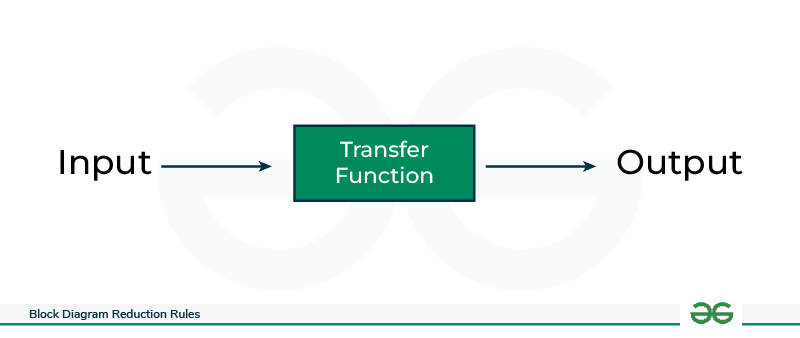
Transfer Function Block Diagram
Transfer Function G(S) = L[c(t)]/L[r(t)] all the initial conditions are zeroes.
G(s) = C(s) / R(s)
It is not always convenient to determine the complete transfer function for the very complex control system. Therefore function of each element of the control system is depicted in the form of a block diagram.
The symbol representation in short form gives a relation of output to input in the control system. The complete system can be formed by connecting each block as per the need of the system.
In this Article, We Will explore various block diagram reduction rules, discuss the advantages and disadvantages of this technique, and examine its applications. Additionally, a solved example will be presented to illustrate the practical application of block diagram reduction rules in simplifying complex systems.
Block Diagram Reduction Rules
To form a control system the block are arranged together as required and the steps followed to obtain the transfer function are called Block Diagram Reduction Method.
Following are the rules to be followed during finding the transfer function of the system
Rule 1 : when more than one block is cascaded than overall transfer function is multiplication of all the transfer function .
G1(s) = C1(s)/ R(s) ; G2(s) = C2(s) / C1(s) ; G3(s) = C(s) / C2(s)
C(s) / R(s) = G1(s) . G2(s) . G3(s)
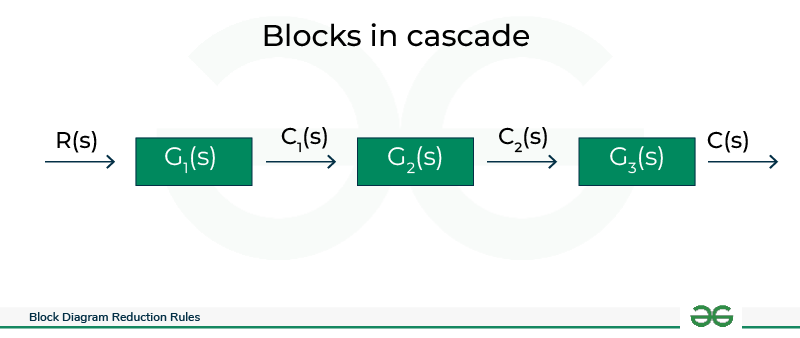
Blocks in cascade

Block in Equivalence
Rule 2 : When two or more input signal enters into system that point is known as Summing Point and the output coming out from summing point will be the sum of all the input entered through summing point .
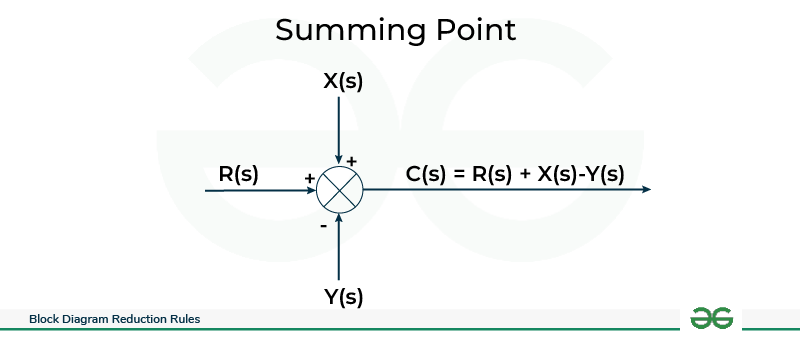
Summing Point
Rule 3 : When there are two or more summing point than we can change the position of summing point with each other as shown below in fig .
.png)
Interchange of summing point
Rule 4 : When one or more blocks are connected in parallel to other block than the final equivalent transfer function can be find as following
C(s) = R(s) G1(s) + R(s) G2(s) + R(s) G3(s)
C(s) = R(s) [ G1(s) + G2(s) + G3(s) ]
C(s) /R(s) = G1(s) + G2(s) + G3(s)
.png)
Blocks in Parallel
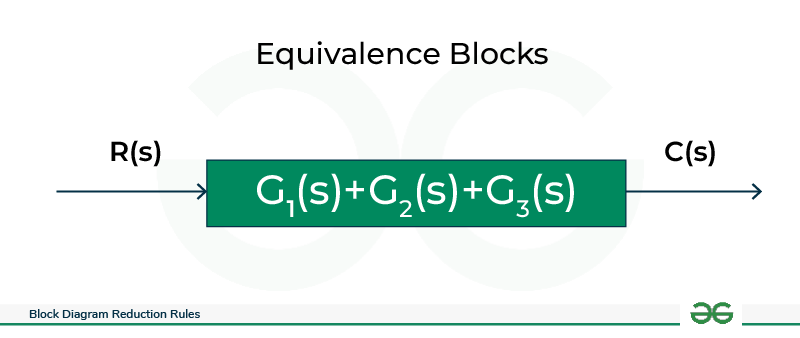
Equivalence Blocks
Rule 5 : When take off point is shifted from position before block to a position after block than a block is added having gain equals to reciprocal of current gain as shown below.
.png)
Shifting of take-off point from A to B
Rule 6 : When take off point is shifted from a position after block to a position before the block than a block is added having gain equals to current gain as shown below .
.png)
Shifting the off point from B to A
Rule 7 : When a summing point is shifted from a position before a block to position after the block , a block is added to summing point having gain equals to current gain .
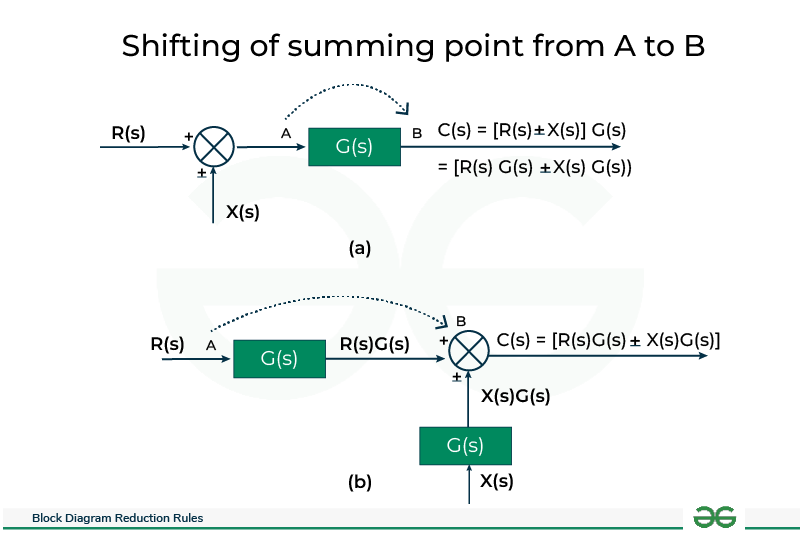
Shifting of Summing Point from A to B
Rule 8 : When a summing point is shifted from a position after a block to a position before the block , a block is added having gain equals to reciprocal of current gain .
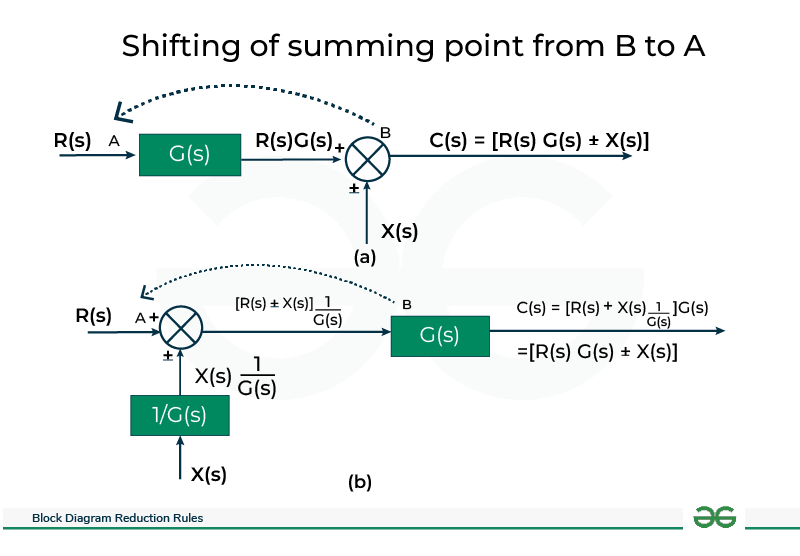
Shifting of Summing Point from B to A
Rule 9 : when a take off point is shifted from a position before a summing point to position after the summing point , it takes place as shown in below fig.
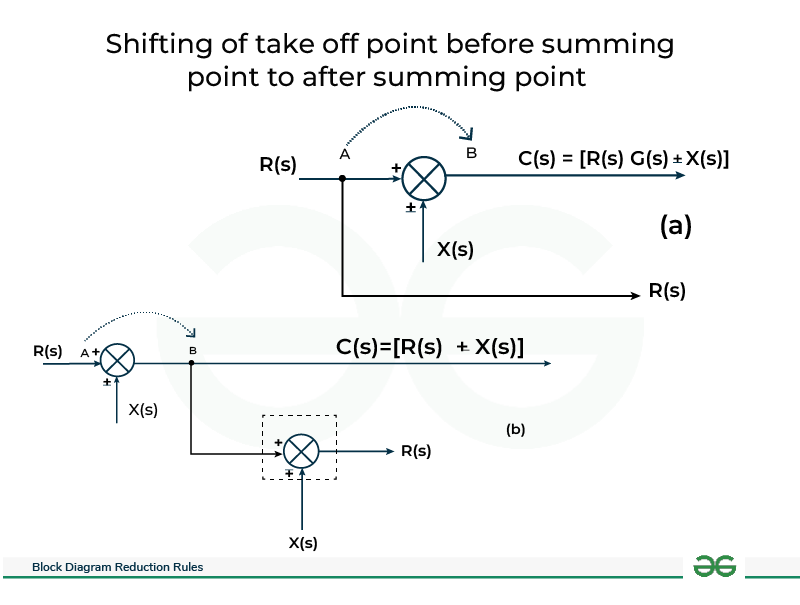
Shifting of take-off point before summing point to after summing point
Rule 10 : Shifting a take off point from a position after a summing point to position before summing point is shown in below fig.
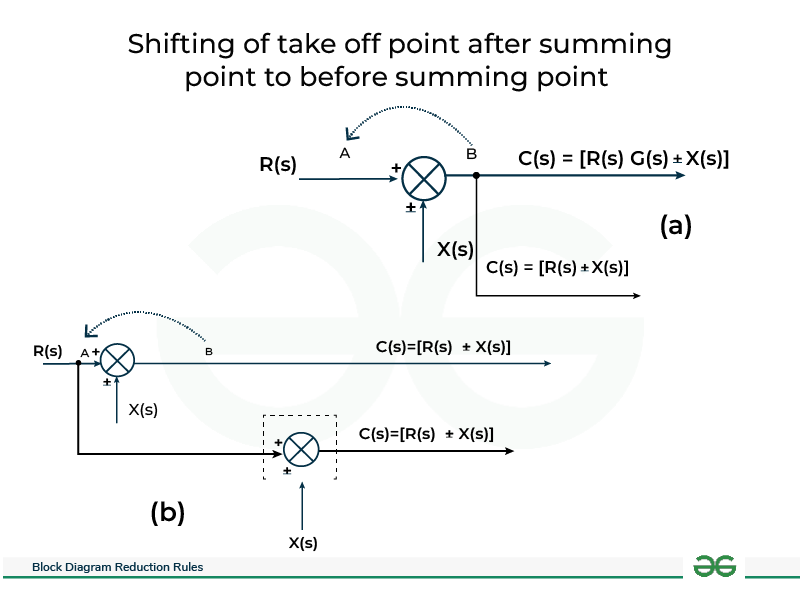
Shifting of take-off point after summing point to before summing point
Rule 11 : Elimination of summing point in closed loop system is done as shown in below fig .
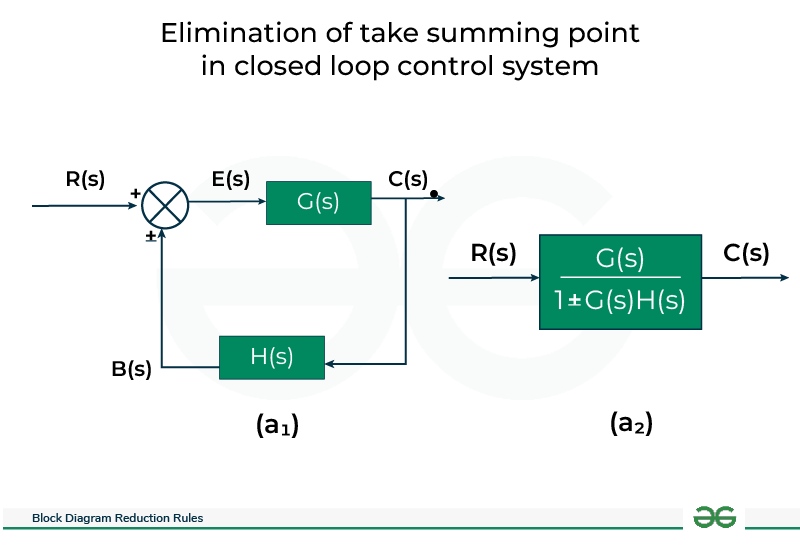
Elimination of the Summing Point in Closed Loop Control System
Advantages of Block Diagram Reduction Rule
Following are some of the advantages of Block Diagram Reduction
- It helps to construct easily block diagrams of complex control systems.
- We can be able to analyze the performance of each block individually.
- We can easily obtain the transfer function of the given control system.
- We can easily find out the stability of the control system through the type of feedback in the system.
- We can observe the functional operation of the Block diagram through it.
Disadvantage of Block Diagram Reduction Rule
Following are some of the Disadvantages of Block Diagram Reduction
- For a complex control system it takes a lot of time.
- During the reduction of the block diagram some important functions of the system may be eliminated.
- There is no information about how the system is constructed physically.
- It does not tell about the source of energy in the system.
Applications of Block Diagram Reduction
Following are some of the Applications of Block Diagram Reduction
- Used in Hardware design.
- Used in electric System Design.
- Used in Software Design.
- Used in Process Flow Diagram.
- Used to determine the transfer function of the system
- Used to find the stability of the system.
Conclusion
The block Diagram reduction rule is a very helpful method for the determination of the transfer function of a complex system. It helps to simplify the complex control system into a simple control system so that we can analyze the stability and other performance of the system easily. It is like a handy way for engineers to troubleshoot and do the observation of complex systems by connecting a simple simple blocks to form a complete system.
Solved Problems on Block Diagram Reduction
Reduce the following block diagram using the block diagram reduction rule
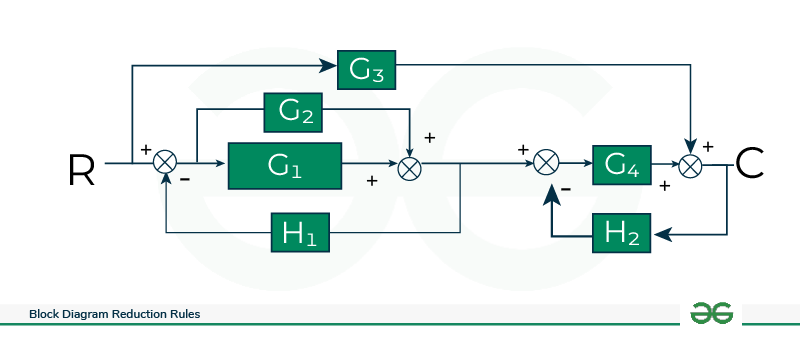
Figure 1
Solution :
Step 1 : G1 and G2 are connected in parallel , find its equivalent block G1 + G2
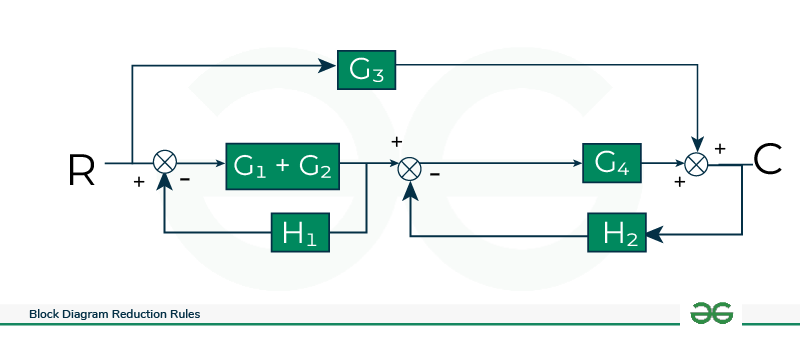
Figure 2
Step 2 : Elimination of summing point before G1 + G2 having negative feedback H1 in closed loop system.
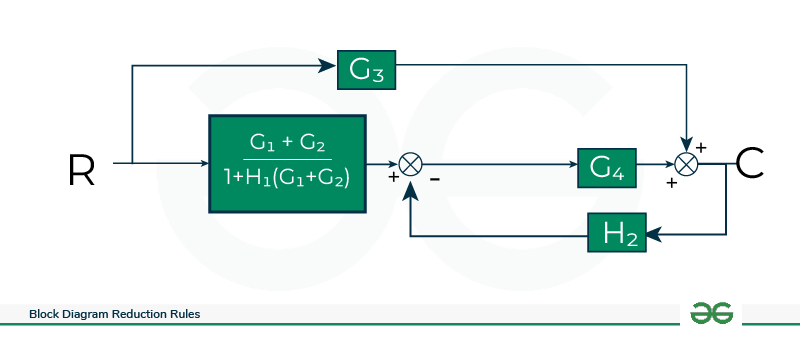
Figure 3
Step 3 : Move summing point after G4 to before G4.
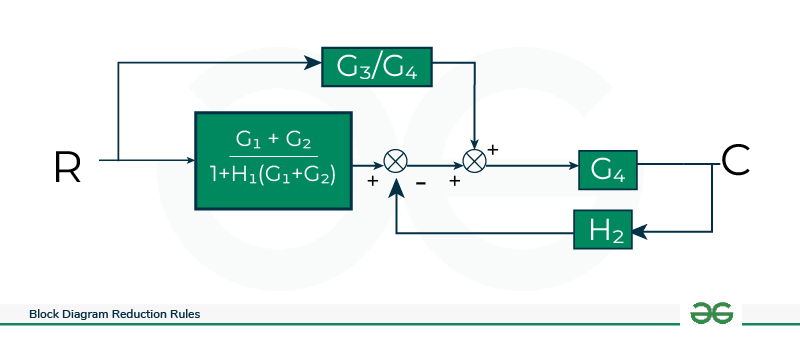
Figure 4
Step 4 : Exchange the position of both the summing point before G4
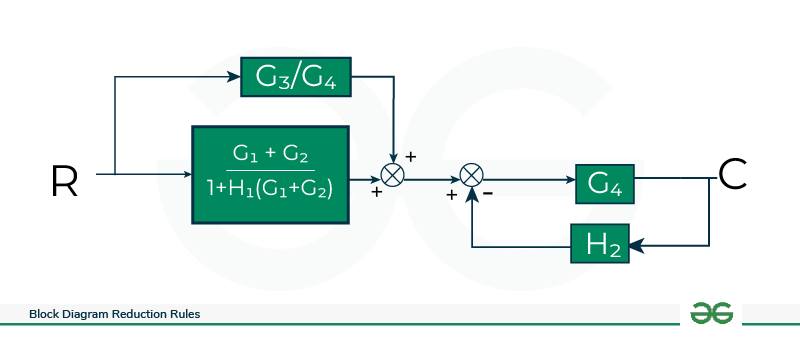
Figure 5
Step 5 : G3 /G4 and (G1 +G2) / (1+G1H1+G2H2) both blocks are connected in parallel . Find equivalent block .
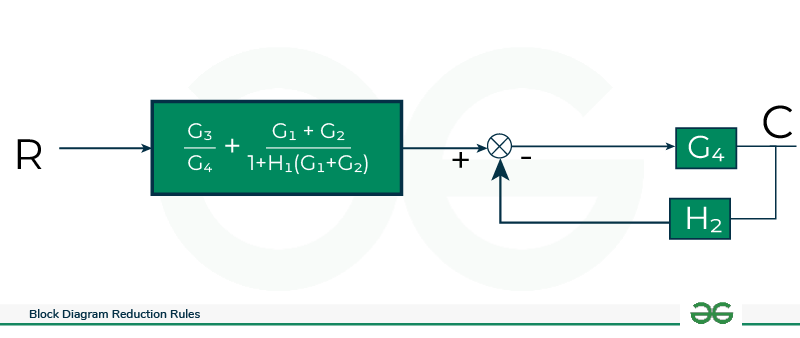
Figure 6
Step 6 : Eliminate summing point before G4 having negative feedback in closed loop system.

Figure 7
Step 7 : Find the equivalent of both the cascaded block .
Single block diagram representation as shown below.
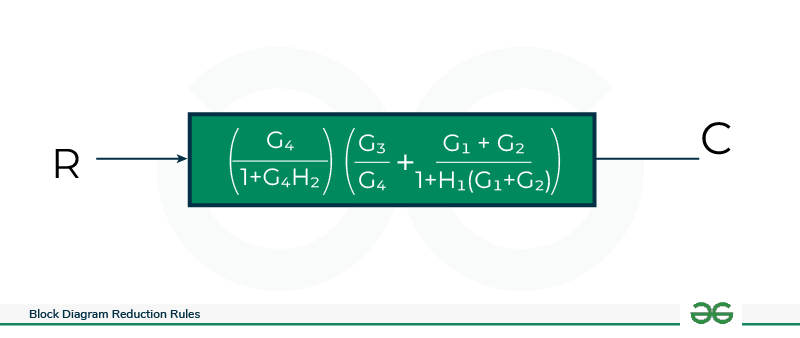
Figure 8
FAQs on Block Diagram Reduction Rules
What are the disadvantages of the transfer function Approach
This approach is Applicable Only for Linear Time Invariant System.
Advantage of State Variable Approach over Transfer Function Approach
We can find controllability and Observability of system through state variable approach but not through transfer function approach.
Which one is better Signal flow graph method or the block diagram reduction method
For complex system SFG method is easy but Block diagram reduction is time consuming .
What are the main components of block diagram reduction
Main Component of Block Diagram Reduction are Signal ,Summing Point , Take off point and systems.
Share your thoughts in the comments
Please Login to comment...